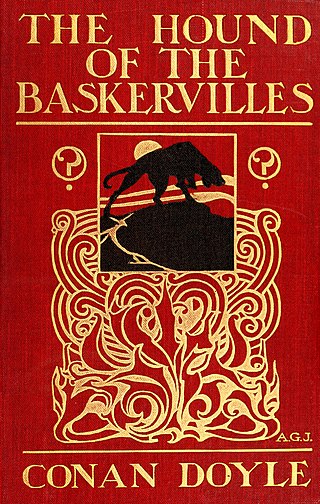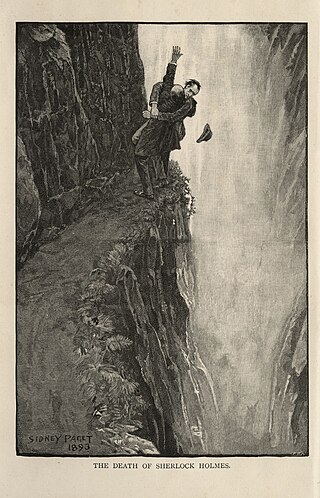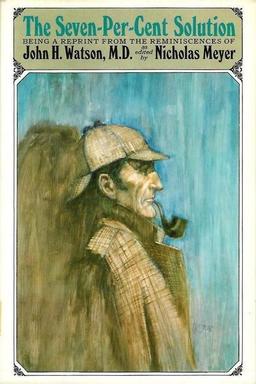
The Hound of the Baskervilles is the third of the four crime novels by British writer Arthur Conan Doyle featuring the detective Sherlock Holmes. Originally serialised in The Strand Magazine from August 1901 to April 1902, it is set largely in Dartmoor, Devon, in England's West Country and follows Holmes and Watson investigating the legend of a fearsome, diabolical hound of supernatural origin. This was the first appearance of Holmes since his apparent death in "The Final Problem", and the success of The Hound of the Baskervilles led to the character's eventual revival.

John Dickson Carr was an American author of detective stories, who also published using the pseudonyms Carter Dickson, Carr Dickson, and Roger Fairbairn.

A Study in Scarlet is an 1887 detective novel by British writer Arthur Conan Doyle. The story marks the first appearance of Sherlock Holmes and Dr. Watson, who would become the most famous detective duo in English literature. The book's title derives from a speech given by Holmes, a consulting detective, to his friend and chronicler Watson on the nature of his work, in which he describes the story's murder investigation as his "study in scarlet": "There's the scarlet thread of murder running through the colourless skein of life, and our duty is to unravel it, and isolate it, and expose every inch of it."

"The Adventure of the Mazarin Stone" is one of 12 Sherlock Holmes short stories by Arthur Conan Doyle in The Case-Book of Sherlock Holmes (1927). It was first published in The Strand Magazine in the United Kingdom in October 1921, and was also published in Hearst's International in the United States in November 1921.

"The Final Problem" is a short story by Sir Arthur Conan Doyle featuring his detective character Sherlock Holmes. It was first published in The Strand Magazine in the United Kingdom, and McClure's in the United States, under the title "The Adventure of the Final Problem" in December 1893. It appears in book form as part of the collection The Memoirs of Sherlock Holmes.

George Edward Challenger is a fictional character in a series of fantasy and science fiction stories by Sir Arthur Conan Doyle. Unlike Doyle's self-controlled, analytical character, Sherlock Holmes, Professor Challenger is an aggressive, hot-tempered, dominating figure.

The Case-Book of Sherlock Holmes is the final set of twelve Sherlock Holmes short stories by British writer Arthur Conan Doyle first published in the Strand Magazine between October 1921 and April 1927.

The Seven-Per-Cent Solution: Being a Reprint from the Reminiscences of John H. Watson, M.D. is a 1974 novel by American writer Nicholas Meyer. It is written as a pastiche of a Sherlock Holmes adventure, and was made into a film of the same name in 1976.

The Lost World is a science fiction novel by British writer Sir Arthur Conan Doyle, published by Hodder & Stoughton in 1912, concerning an expedition to a plateau in the Amazon basin of South America where prehistoric animals still survive. It was originally published serially in the Strand Magazine and illustrated by New-Zealand-born artist Harry Rountree during the months of April–November 1912. The character of Professor Challenger was introduced in this book. The novel also describes a war between indigenous people and a vicious tribe of ape-like creatures.

The Valley of Fear is the fourth and final Sherlock Holmes novel by British writer Arthur Conan Doyle. It is loosely based on the Molly Maguires and Pinkerton agent James McParland. The story was first published in the Strand Magazine between September 1914 and May 1915. The first book edition was copyrighted in 1914, and it was first published by George H. Doran Company in New York on 27 February 1915, and illustrated by Arthur I. Keller.

The Poison Belt is a science fiction novel by British writer Arthur Conan Doyle, the second book about Professor Challenger. Written in 1913, much of it takes place in a single room in Challenger's house in Sussex. This would be the last story written about Challenger until the 1920s, by which time Doyle's spiritualist beliefs had begun to influence his writing.

Colonel Sebastian Moran is a fictional character in the stories written by Arthur Conan Doyle. An enemy of Sherlock Holmes, he first appears in the 1903 short story "The Adventure of the Empty House". Holmes once described him as "the second most dangerous man in London", the most dangerous being Professor Moriarty, Moran's employer.
Sherlock Holmes has long been a popular character for pastiche, Holmes-related work by authors and creators other than Arthur Conan Doyle. Their works can be grouped into four broad categories:

Micah Clarke is a historical adventure novel by British author Arthur Conan Doyle, published in 1889 and set during the Monmouth Rebellion of 1685 in England. The book is a bildungsroman whose protagonist, Micah Clarke, begins as a boy seeking adventure in a rather romantic and naive way, falls under the influence of an older and vastly experienced, world-weary soldier of fortune, and becomes a grown up after numerous experiences, some of them very harrowing. At the conclusion he must go into exile as a hunted outlaw, becomes a soldier of fortune himself and is launched on lifetime military career. In the process the book also records much of the history of the Monmouth Rebellion, from the point of view of someone living in 17th century England.

Brigadier Gerard is the hero of a series of 17 historical short stories, a play, and a major character in a novel by the British writer Arthur Conan Doyle. Brigadier Etienne Gerard is a Hussar officer in the French Army during the Napoleonic Wars. Gerard's most notable attribute is his vanity – he is utterly convinced that he is the bravest soldier, greatest swordsman, most accomplished horseman and most gallant lover in all France. Gerard is not entirely wrong, since he displays notable bravery on many occasions, but his self-satisfaction undercuts this quite often. Obsessed with honour and glory, he is always ready with a stirring speech or a gallant remark to a lady.

Traditionally, the canon of Sherlock Holmes consists of the 56 short stories and four novels written by Sir Arthur Conan Doyle. In this context, the term "canon" is an attempt to distinguish between Doyle's original works and subsequent works by other authors using the same characters. Usually capitalized by fans of the Sherlockian game as "the Canon", the description of these 60 adventures as the Sherlock Holmes canon and the game of applying the methods of "Higher Criticism" to it was started by Ronald Knox as a playful use of the traditional definition of canon as an authoritative list of books accepted as holy scripture.

Sir Arthur Ignatius Conan Doyle was a British writer and physician. He created the character Sherlock Holmes in 1887 for A Study in Scarlet, the first of four novels and fifty-six short stories about Holmes and Dr. Watson. The Sherlock Holmes stories are milestones in the field of crime fiction.

Undershaw is a former residence of the author Sir Arthur Conan Doyle, the creator of Sherlock Holmes. The house was built for Doyle at his order to accommodate his wife's health requirements, and is where he lived with his family from 1897 to 1907. Undershaw is where Doyle wrote many of his works, including The Hound of the Baskervilles.
John Michael Drinkrow Hardwick, known as Michael Hardwick, was an English author who was best known for writing books and radio plays which featured Sir Arthur Conan Doyle's creation Sherlock Holmes. He adapted most of the episodes of the Sherlock Holmes BBC radio series 1952–1969.
Good Morning, Bill is a comedic play by P. G. Wodehouse, adapted from the Hungarian play Doktor Juci Szabo by playwright Ladislaus Fodor. It premiered in London at the Duke of York's Theatre in 1927.
















